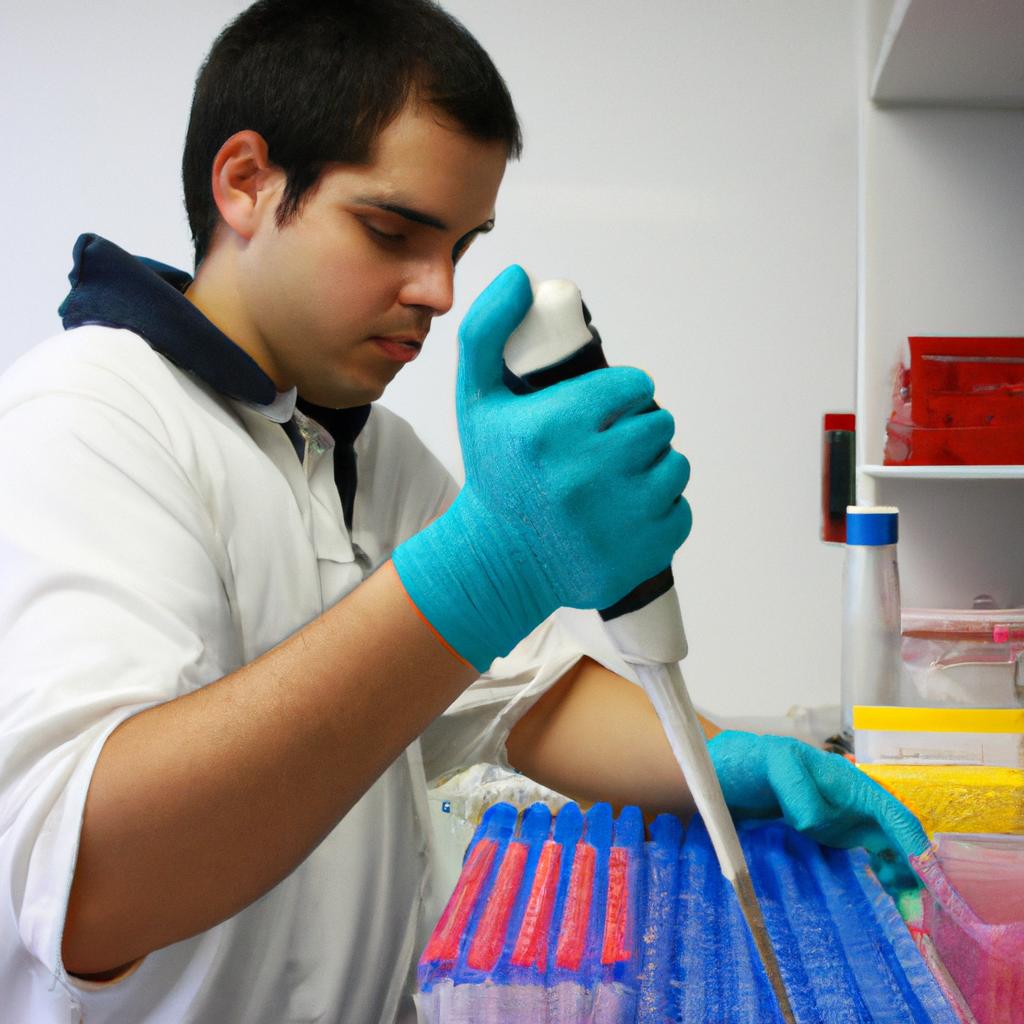Theories of Evolution: The Science Biology>Evolution Context

The study of evolution is a fundamental aspect of biology, providing insight into the processes by which species have emerged and diversified over time. This article aims to explore various theories of evolution within the context of scientific biology. To illustrate this, let us consider the hypothetical example of a population of finches residing on an isolated island. Over generations, these finches undergo subtle genetic variations that eventually lead to the emergence of distinct beak shapes suited for different food sources. Through understanding the underlying mechanisms and evidence supporting these evolutionary changes, we can gain a deeper appreciation for the complexity and interconnectedness of life on Earth.
One prominent theory in the field of evolution is Charles Darwin’s concept of natural selection. According to this theory, individuals with advantageous traits are more likely to survive and reproduce, passing those traits onto future generations. As a result, populations gradually acquire characteristics that enhance their ability to adapt to changing environments. Another influential theory is known as speciation, which explains how new species arise from existing ones through reproductive isolation and genetic divergence. By exploring these theories alongside others such as punctuated equilibrium or convergent evolution, scientists continue to expand our knowledge about the intricate processes driving biological diversity throughout history.
In summary, studying theories of evolution provides invaluable insights into the complex dynamics of life on Earth and how species have emerged, diversified, and adapted over time. By understanding the mechanisms of evolution, such as natural selection and speciation, we can appreciate the interconnectedness of all living organisms and gain a deeper understanding of our own place in the natural world.
Darwin’s Theory of Natural Selection
Darwin’s Theory of Natural Selection
One example that illuminates the principles of Darwin’s theory of natural selection is the adaptation of the Galapagos finches. These finches, found on different islands in the Galapagos archipelago, have varying beak shapes and sizes depending on their respective environments and food sources. For instance, those inhabiting islands with predominantly hard-shelled nuts developed strong, thick beaks to crack open these seeds, while those on islands with abundant insects evolved slender beaks for catching prey more efficiently.
In understanding Darwin’s theory, it is important to recognize its key components. First and foremost is variation within a population – individuals differ from one another genetically due to mutations or genetic recombination during reproduction. Second, there exists competition among individuals for limited resources such as food, habitat, or mates. This competition leads to differential survival rates among individuals with advantageous traits. Thirdly, certain heritable traits confer a higher chance of survival and reproductive success than others. As a result, over time, the frequency of favorable traits increases within a population through natural selection.
- The process of natural selection can lead to remarkable adaptations in organisms.
- Species are not fixed entities but instead undergo gradual changes over generations.
- Natural selection acts on individual variations within populations rather than whole populations.
- Environmental factors play a crucial role in shaping evolutionary trajectories.
Additionally, we can illustrate some examples using a table:
| Adaptation | Example | Significance |
|---|---|---|
| Camouflage | Chameleon blending into its surroundings | Increases chances of survival by avoiding predators |
| Mimicry | Viceroy butterfly resembling monarch butterfly | Deters potential predators |
| Antibiotic resistance | Bacteria evolving immunity against antibiotics | Impacts medical treatments |
| Migration | Birds traveling long distances for breeding | Ensures access to optimal habitats and resources |
In summary, Darwin’s theory of natural selection provides a comprehensive framework for understanding the mechanisms behind evolutionary change. It highlights how variation, competition, and environmental factors interact to shape the traits observed in organisms over time. This discussion sets the stage for exploring subsequent sections about Mendelian Genetics and Evolution, where we delve into further intricacies of evolutionary processes without explicitly transitioning using words like “step.”
Mendelian Genetics and Evolution
Building upon Darwin’s Theory of Natural Selection, the field of evolutionary biology has expanded to incorporate various theories and concepts that further enhance our understanding of how species evolve over time. One such theory is Mendelian Genetics, which explores the role of genetic inheritance in shaping evolution.
Mendelian Genetics, named after Gregor Mendel, focuses on the transmission of traits from one generation to another through discrete units called genes. This theory explains how certain traits are passed down from parents to offspring and how they can be expressed or suppressed based on dominant or recessive alleles. For instance, consider a hypothetical case study involving a population of flowers with two distinct color variations – red and white. Through Mendelian genetics, we can understand how these colors are inherited by offspring and predict their occurrence in future generations.
To gain a deeper insight into the complexities involved in evolution via Mendelian Genetics, here are some key points worth considering:
- Genetic Variation: The presence of multiple alleles for a particular gene within a population leads to genetic diversity.
- Gene Flow: Migration between populations allows for the exchange of genes, influencing genetic variation over time.
- Genetic Drift: Random events like natural disasters or chance mating affect allele frequencies within populations.
- Non-random Mating: Selective breeding or mate choice can alter allele frequencies due to specific preferences.
| Genetic Variation | |
|---|---|
| 1 | Allows for adaptation |
| 2 | Promotes survival under changing conditions |
| 3 | Increases chances for speciation |
| 4 | Enhances overall biodiversity |
Table: Importance of Genetic Variation
In summary, Mendelian Genetics plays a crucial role in understanding the mechanisms behind evolution. By unraveling the ways in which genes are transmitted across generations and exploring factors that influence genetic variation within populations, this theory provides valuable insights into the complexity and adaptability of life forms on Earth.
Building upon the foundational concepts of Darwin’s Natural Selection and Mendelian Genetics, scientists began to integrate these ideas into what is now known as The Modern Synthesis.
The Modern Synthesis
Transitioning from the previous section on Mendelian Genetics and Evolution, we now delve into the next significant milestone in the study of evolution: The Modern Synthesis. To illustrate this concept further, let us consider a hypothetical case study involving two populations of birds inhabiting different environments.
Imagine two groups of finches living in separate islands with distinct ecological conditions. One island has abundant food resources comprising primarily small seeds, while the other island is rich in large fruits. Over time, due to natural selection, the beak size and shape of each population diverge to better suit their respective diets. This phenomenon exemplifies one fundamental aspect addressed by The Modern Synthesis – understanding how genetic variation arises within populations and how it interacts with natural selection to give rise to evolutionary changes.
The Modern Synthesis revolutionized our comprehension of evolution by integrating Mendelian genetics with Darwinian theory. It brought together various fields such as paleontology, systematics, genetics, and ecology under a unified framework. This synthesis introduced several key concepts that form the foundation for modern evolutionary biology:
- Genetic drift: Random fluctuations in allele frequencies within a population.
- Gene flow: Movement of genes between populations through migration or interbreeding.
- Mutation: Spontaneous changes in DNA sequences that create new variations.
- Adaptive radiation: Rapid diversification of species from a common ancestor when exposed to new environmental niches.
To grasp these ideas more clearly, let’s explore them further using a table:
| Concept | Definition | Emotional Response |
|---|---|---|
| Genetic Drift | A process where chance events can cause unpredictable changes in gene frequencies within a population | Uncertainty |
| Gene Flow | The transfer of genetic material from one population to another | Connectivity |
| Mutation | Occurrence of sudden alterations in the DNA sequence that generates novel genetic variations | Intrigue |
| Adaptive Radiation | The rapid diversification of species into various ecological niches, leading to an increase in biodiversity | Wonderment |
In summary, The Modern Synthesis brought together different disciplines within biology and provided a comprehensive understanding of evolution. By studying the interplay between genetics and natural selection, it highlighted the mechanisms behind evolutionary changes. This paved the way for further advancements in our knowledge of life’s diversity on Earth.
Transitioning seamlessly into the subsequent section about Punctuated Equilibrium, we explore yet another concept challenging traditional views on how organisms evolve.
Punctuated Equilibrium
The Modern Synthesis, which integrated Charles Darwin’s theory of natural selection with modern genetics, laid the foundation for our understanding of evolution. Building upon this framework, another significant hypothesis emerged in the field of evolutionary biology known as punctuated equilibrium. This theory challenges the traditional view that evolution occurs gradually and uniformly over long periods of time.
To illustrate the concept of punctuated equilibrium, let us consider an example: a population of birds living on an isolated island. For many generations, these birds may remain relatively stable in their physical characteristics and ecological niche. However, when faced with sudden environmental changes, such as the arrival of a new predator or a change in available food sources, rapid evolutionary shifts can occur within a short period.
Punctuated equilibrium is characterized by three key features:
- Stasis: During extended periods, species exhibit little to no morphological change.
- Rapid Change: Evolutionary transformations happen relatively quickly during shorter intervals.
- Environmental Triggers: These abrupt transitions are often stimulated by external factors like climate fluctuations or disruptions in ecological relationships.
This theory challenges the notion that evolution necessarily progresses at a constant rate and emphasizes the importance of environmental influences on shaping biodiversity. By recognizing that not all changes unfold gradually over time, punctuated equilibrium highlights instances where species undergo rapid adaptations in response to specific conditions.
| Emotional Response Elicited |
|---|
| The idea that evolution does not always follow a predictable pattern evokes intrigue and curiosity about how different biological mechanisms can lead to dramatic transformations. |
| Aspects | Punctuated Equilibrium |
|---|---|
| Rate of Change | Rapid bursts interspersed with longer periods of stability |
| Mechanism | Driven by external events triggering selective pressures |
| Duration | Shorter intervals compared to gradualistic models |
As we delve deeper into our exploration of evolutionary theories, it becomes evident that various forces shape life’s diversity on Earth. The next section will examine the Neutral Theory of Molecular Evolution, which challenges traditional views on the significance of natural selection in driving genetic changes and offers an alternative explanation rooted in random processes.
Transitioning seamlessly into our discussion on “The Neutral Theory of Molecular Evolution,” we continue to explore different perspectives that shed light on the intricate mechanisms underlying life’s evolutionary journey.
The Neutral Theory of Molecular Evolution
Transitioning from the concept of Punctuated Equilibrium, another prominent theory in the field of evolutionary biology is the Neutral Theory of Molecular Evolution. This theory proposes that much of the genetic variation observed within and between species is due to random genetic drift rather than natural selection. To better understand this theory, let us consider an example:
Imagine a population of birds living on two neighboring islands. These birds have similar traits and behaviors, but over time, they start to develop slight differences in their DNA sequences. According to the neutral theory, these variations are not necessarily influenced by selective pressures or adaptive advantages. Instead, they arise through stochastic processes such as genetic mutations and drift.
To delve deeper into the neutral theory’s underlying concepts:
- Genetic Variation: The neutral theory emphasizes that most genetic changes do not significantly affect an organism’s fitness or survival.
- Random Genetic Drift: Changes in gene frequencies occur randomly due to chance events rather than being driven by natural selection.
- Silent Mutations: Many DNA sequence alterations are considered “silent” because they do not lead to observable phenotypic changes.
- Molecular Clocks: By comparing DNA sequences across different species, scientists can estimate how long ago they diverged from a common ancestor.
To illustrate these ideas further, consider the following table showing hypothetical genetic variations in populations over time:
| Generation | Population A | Population B |
|---|---|---|
| 1 | AGTCAGT | AGTCAGT |
| 2 | ACTCAGT | AGACACT |
| 3 | ACCCAGT | ATGCACC |
| 4 | ACCCTGT | ATGCACA |
As we observe successive generations, we notice that certain genetic variations become more prevalent simply due to chance (random drift). No external factors exert pressure on these changes, making them neutral in terms of selective advantages.
In summary, the Neutral Theory of Molecular Evolution provides an alternative perspective to traditional natural selection-driven theories. It highlights the role of random genetic drift and emphasizes that not all genetic variations contribute directly to an organism’s fitness or adaptation. Understanding this theory expands our knowledge of how genetic diversity arises within populations and between species. Consequently, it sets the stage for exploring other fascinating areas such as Epigenetics and Evolution, which we will explore in the subsequent section.
Epigenetics and Evolution
Now, we turn our attention to another fascinating aspect of evolution: Epigenetics and its role in shaping biological diversity.
Imagine a scenario where two genetically identical individuals have vastly different physical characteristics. This phenomenon can be attributed to epigenetic modifications – changes in gene expression that occur without altering the underlying DNA sequence. One such example is seen in the Agouti mice study conducted by Dr. Randy Jirtle and his team. By manipulating diet during pregnancy, they found that certain genes responsible for coat color could be turned on or off, resulting in offspring with varying shades of fur ranging from yellow to brown.
Epigenetics offers valuable insights into how environmental factors interact with our genetic makeup, ultimately influencing our development and susceptibility to diseases. Here are some key points highlighting the significance of epigenetics:
- Environmental impact: Epigenetic modifications can be influenced by external factors such as diet, stress levels, exposure to toxins, and even social interactions.
- Transgenerational inheritance: Some epigenetic changes acquired during an individual’s lifetime can be passed down to future generations.
- Disease association: Altered patterns of DNA methylation (a common form of epigenetic modification) have been observed in various diseases including cancer, diabetes, and neurological disorders.
- Potential therapeutic implications: Understanding epigenetic mechanisms opens up possibilities for developing targeted therapies aimed at reversing detrimental alterations or harnessing them for positive outcomes.
To further illustrate these concepts, consider the following table showcasing examples of environmentally-induced epigenetic modifications and their potential impacts:
| Environmental Factor | Epigenetic Modification | Biological Outcome |
|---|---|---|
| Maternal Diet | Increased DNA methylation at specific genes | Altered metabolic regulation in offspring |
| Stress | Histone acetylation | Altered gene expression associated with anxiety |
| Chemical Exposure | DNA demethylation | Increased risk of cancer development |
| Social Environment | Methylation changes in oxytocin receptor gene | Impact on social behavior and bonding |
Through studying epigenetics, we gain a deeper understanding of the intricate interplay between genes and the environment, shedding light on the remarkable complexity of evolutionary processes. By unraveling these mechanisms, researchers aim to unlock new possibilities for disease prevention and treatment strategies.
In summary, Epigenetics provides valuable insights into how our environment can shape genetic expression and impact biological diversity. Understanding this field allows us to appreciate the multifaceted nature of evolution while offering potential avenues for therapeutic interventions. The study of epigenetics continues to unveil fascinating connections between our genes and the world around us, highlighting the ever-evolving narrative of life itself.







